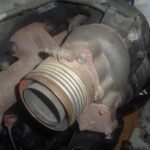Continental kits, the iconic rear-mounted spare tire accessories, evoke the spirit of classic 1950s and 60s automobiles. These kits, once a popular factory and aftermarket option, continue to be sought after by car enthusiasts looking to add a touch of vintage style and flair to their vehicles. This article explores the history, manufacturing, and enduring appeal of Continental Kits For Cars.
The History of Continental Kits
The origin of the continental kit can be traced back to the 1940s Lincoln Continental, designed by Edsel Ford. The car’s distinctive long front and short rear profile, with the spare tire integrated into the body design, set a new standard for automotive styling. Following World War II, the popularity of the continental look soared, prompting aftermarket manufacturers to produce kits for a wide range of car makes and models. Companies like Foxcraft, Stylecraft, Lido, and Bonzer-Western offered various designs, with prices starting as low as $28. These kits transformed ordinary vehicles into head-turning cruisers, embodying the glamour and optimism of the era. One notable example was the Huddleston-Whitebone kit for the 1953 Cadillac Eldorado, featuring a hinged tire carrier for easy trunk access.
The Manufacturing Process of Continental Kits
Original continental kits typically consisted of steel components: extended bumpers, a pivoting tire carrier, filler panels to bridge the gap between the car and the extended bumper, and decorative chrome or painted wheel covers. Today, companies like Continental Enterprises continue the tradition of crafting high-quality continental kits. They utilize modern manufacturing techniques, including metal shaping, pressing with 100-ton presses, and employing meticulously crafted patterns and dies to reproduce original designs with precision.
Continental Enterprises: The Modern Continental Kit King
Sam Bronstein, the founder of Continental Enterprises, has dedicated his life to preserving the legacy of continental kits. Starting in the 1970s with a single kit found at a swap meet, Bronstein built a thriving business by meticulously duplicating original designs and expanding his inventory. He recognized the importance of offering a wide variety of kits to cater to different car models and enthusiast preferences. His commitment to quality and authenticity led him to invest in manufacturing original dealer-option kits, ensuring that every detail matched the factory specifications.
Finding the Perfect Continental Kit
Continental Enterprises currently offers continental kits for over 200 car models, spanning the most popular vehicles of the 1950s and 1960s. Kits range in price from $895 to $2,195 and include options for chrome or painted tire rings, solid or hubcap-style faceplates, ensuring a personalized touch for each vehicle. Whether you own a classic Chevrolet, Ford, or Pontiac, there’s likely a continental kit available to enhance its vintage appeal. The company ships worldwide, serving a global community of passionate car enthusiasts.
The Enduring Appeal of Continental Kits
The enduring appeal of continental kits lies in their ability to transform a car’s appearance, adding a touch of nostalgia and individuality. They are a testament to a bygone era of automotive design, when cars were more than just transportation; they were statements of personal style. For enthusiasts, installing a continental kit is a way to connect with the past, honor the craftsmanship of original designers, and make their classic car stand out from the crowd. Continental kits remain a sought-after accessory for car enthusiasts who appreciate the artistry and history of automotive design. They represent a unique way to personalize a classic car and make it a true reflection of its owner’s passion for vintage style.

